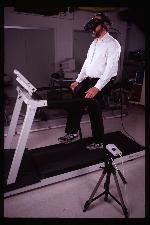
 |
Improving Stepping-over Responses in the Elderly using Simulated Objects |
| Principal Investigators: Intervention Physical Therapist: Evaluation Physical Therapist: Pulmonary Care Physician: Pulmonary Care Technical Director: |
David A. Brown, PhD PT and David L. Jaffe, MS Cheryl D. Pierson-Carey, MS PT Ellie Buckley, MS PT Rajinder Chitkara, MD James Canfield, BS-CCPT |
Summary: The long term goal of this work is to construct and test a system for elderly individuals at high risk for falling that 1) employs techniques to monitor and improve their stepping-over response time and 2) trains them in more effective movement strategies. Simulated obstacles of various sizes will be presented to subjects via a head mounted display as they walk on a treadmill. Foot height will be monitored to analyze users' movements and detect collisions between the virtual object and the users' feet. This method is expected to be safer than conventional training, more rapid and precise in the feedback it provides to the patient, and it should promote effective stepping-over movement strategies.
Purpose: The long term goal of this work is to construct and test a system for elderly individuals at high risk for falling that employs techniques to monitor and improve their stepping-over response time and trains them in more effective movement strategies. This method is expected to be safer than conventional training and more rapid and precise in the feedback it provides to the patient.
Methodology: Simulated obstacles of various heights and lengths will be presented to subjects wearing a head mounted display as they walk on a treadmill. Foot position will be monitored by a computer to detect collisions between the virtual object and the users' feet. During trials, vibrotactile feedback will be presented to the heel or toe of the foot involved in a collision.
Progress: In the past four months a laboratory setup has been developed. Subjects will wear an overhead harness to prevent injury in the case of a fall during treadmill walking. A color video camera will be trained on the subjects' legs from the side. This real time image will be viewed by the subject wearing a head mounted display. The computer will add virtual images of rectangular objects of varying heights and lengths at the subjects' feet. The subject will be instructed to step over the obstacles on each step. The computer will capture the images and detect any intersection of the user's feet with the virtual obstacles. A collision by the toe on the front edge of the object would indicate that the subject has not lifted the foot high enough, while a collision with the heel on the top of the object would indicate that the subject has not stepped far enough. Foot switches determine which foot is off the ground. The vibrotactile feedback would then be directed to the heel or toe of the foot that caused the collision.
Preliminary Results: The pilot project work has led to the following conclusions:
The most successful technique involves displaying a side-view of stepping on a treadmill while the viewer repeatedly negotiates computer-generated obstacles.
When stepping over obstacles during overground walking, young, healthy persons step over higher objects by increasing knee and hip flexion. This same strategy is employed when stepping over computer-generated obstacles displayed during treadmill walking.
When stepping over obstacles during overground walking, young, health persons step over longer objects by increasing stride length. This same strategy is employed when stepping over computer-generated obstacles displayed during treadmill walking.
In a small group of elderly subjects, the proposed training regimen showed a positive result in that subjects were better able to negotiate an overground obstacle course after three training sessions. A randomized, controlled study must be conducted to separate out the nonspecific effects.
Future Plans: Future studies include studies on frail elderly individuals with a history of falls to determine if this intervention can result in reduced frequency of falls. In addition, we plan to further develop the system so that it can be used in a wide variety of clinical settings and clinical populations.
Future work in this project area could include employing simulation techniques with walking aids such as canes and crutches. Other potential areas of research include the study of improvements in fitness and gait through simulation of walking situations for ambulatory nursing home patients and teaching environmental factors and modifications to avoid falls. The system could provide an enjoyable and safe environment for general exercise, a safe setting for "wanderers", or a simulated practice session for wayfinding and familiarization of nursing home patients with their facility.
| Contributing Companies: |
||||
Vividgroup 317 Adelaide St., W, Suite 302 Toronto, Ontario Canada M5V 1P9 |
Computer Modules, Inc. 2350 Walsh Ave. Santa Clara, CA 95051 |
Biodex Corp. 20 Ramsey Rd. Shirley, NY 11967-0702 |
||
Recent Publications:
Jaffe, David L., Buckley, Ellie, Pierson-Carey, Cheryl D., and Brown, David
A. Improving Stepping-Over Responses in the Elderly using Simulated Obstacles,
Proceedings of the 2nd VA National Department of Veterans Affairs
Rehabilitation Research and Development Conference, Arlington, VA, February
20-22, 2000.
abstract
Jaffe, David L., Use of Virtual Reality Techniques to Train Elderly People to Step over Obstacles, Proceedings of the 1998 CSUN Technolgy and Persons with Disability Annual Conference, Los Angeles, CA, March 13, 1998.
| Related Work: Merit Review Pilot Study - Obstacle Avoidance - training with computer simulated environments |
 |